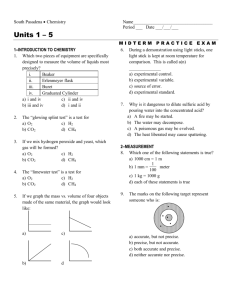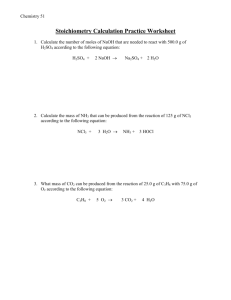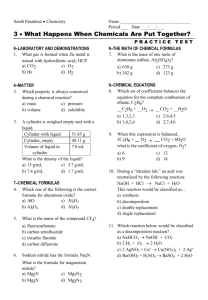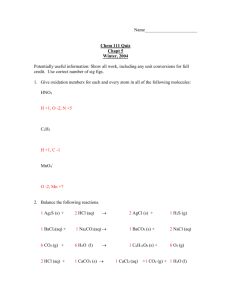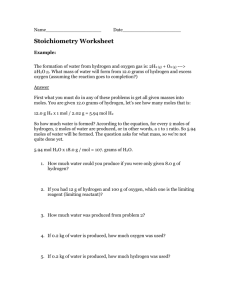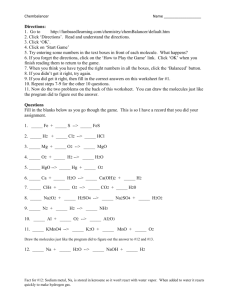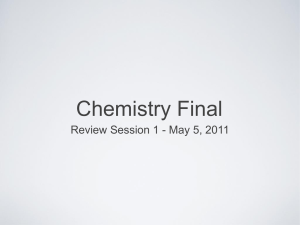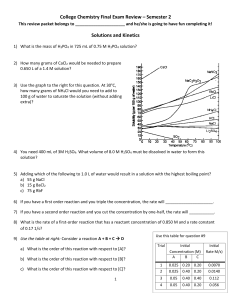Word - Chemmybear.com
advertisement
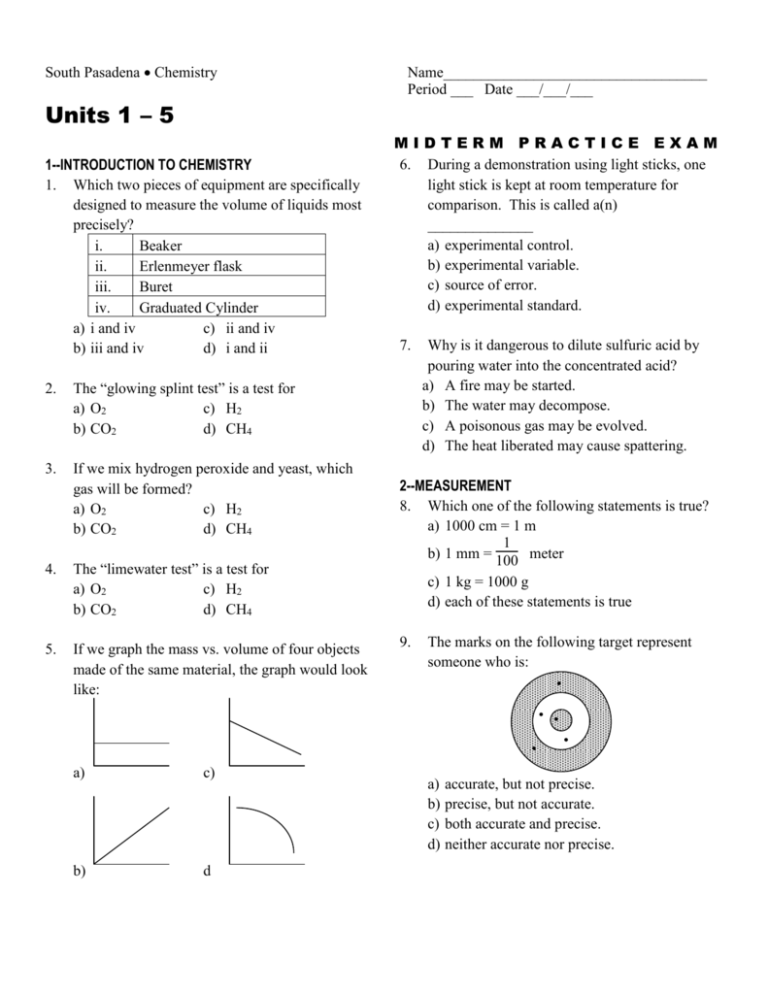
South Pasadena Chemistry Name___________________________________ Period ___ Date ___/___/___ Units 1 – 5 1--INTRODUCTION TO CHEMISTRY 1. Which two pieces of equipment are specifically designed to measure the volume of liquids most precisely? i. Beaker ii. Erlenmeyer flask iii. Buret iv. Graduated Cylinder a) i and iv c) ii and iv b) iii and iv d) i and ii 2. The “glowing splint test” is a test for a) O2 c) H2 b) CO2 d) CH4 3. If we mix hydrogen peroxide and yeast, which gas will be formed? a) O2 c) H2 b) CO2 d) CH4 4. The “limewater test” is a test for a) O2 c) H2 b) CO2 d) CH4 5. If we graph the mass vs. volume of four objects made of the same material, the graph would look like: a) c) b) d MIDTERM PRACTICE EXAM 6. During a demonstration using light sticks, one light stick is kept at room temperature for comparison. This is called a(n) ______________ a) experimental control. b) experimental variable. c) source of error. d) experimental standard. 7. Why is it dangerous to dilute sulfuric acid by pouring water into the concentrated acid? a) A fire may be started. b) The water may decompose. c) A poisonous gas may be evolved. d) The heat liberated may cause spattering. 2--MEASUREMENT 8. Which one of the following statements is true? a) 1000 cm = 1 m 1 b) 1 mm = 100 meter c) 1 kg = 1000 g d) each of these statements is true 9. The marks on the following target represent someone who is: a) b) c) d) accurate, but not precise. precise, but not accurate. both accurate and precise. neither accurate nor precise. 10. The density of copper is known to be 8.96 g/mL. A student’s experimental result shows that the density of her copper cube is 8.79 g/mL. The percent error in this data is ______. a) 1.93 % c) 1.90 % b) 0.17 % d) 0.98 % 11. Which measurement below shows the temperature to the correct precision? 20 mercury thread a) 26.3 °C b) 26 °C 30 c) 26.25 °C d) 26.30 °C 12. Which measurement is the most precise? a) 5.6 .1 g c) 2.3 .2 g b) 3.5 .4 g d) 4.2 .3 g 3--PROBLEM SOLVING 13. What conversion factor would you use to convert from feet to inches? 1 foot 12 feet a) 12 inches c) 1 inch b) 12 inches 1 foot 1 inch d) 12 feet 14. What conversion factor would you use to convert milligrams to grams? 1000 mg 1 gram a) c) 1000 mg 1g b) mg2 1 10 g2 d) 1 g = 1000 mg 15. Which value is the same as 1.52 x 10–3? a) 0.000152 b) 152,000 c) 1520 d) 0.00152 4--MATTER 16. Which property is always conserved during a chemical reaction? a) mass c) pressure b) volume d) solubility 17. A cube of metal measures 2 cm on each side. It’s mass is 90.4 grams. What kind of metal is the cube made of? a) Fe (7.86 g/mL) c) Au (19.3 g/mL) b) Al (2.70 g/mL) d) Pb (11.3 g/mL) 18. Which process is a chemical change? a) The melting of ice. b) The burning of a candle. c) The magnetizing of steel. d) The liquifaction of oxygen. 19. Which set consists only of elements? a) Na, Ca, H2 b) H3O+, Cl –, I3– c) NaCl, CH4, Br2 d) H2S, CuCl2, KI 20. The second most abundant gas in the atmosphere is a) CO2 c) N2 b) Ar d) O2 7--CHEMICAL FORMULAS 21. Which one of the following is the correct formula for calcium phosphate? a) CaPO4 c) Ca3(PO4)2 b) PO4Ca3 d) Ca2(PO4)3 22. What is the name of the compound N2O3? a) nitrate b) dinitrogen trioxide c) nitrogen oxide d) dinitrogen trioxygen 23. In the compound Sn(SO4)2, what is the name of the positive ion? a) strontium c) stannic b) tin(II) d) stannous a) 1,3,2,3 b) 1,6,2,6 24. The acid, H2CO3, is called a) hydrocarbonic acid b) carbonic acid c) dihydrogen carbonate d) hydrogen carbonate c) 2,6,4,5 d) 2,7,4,6 31. When this expression is balanced, 2 C3H6 + ? O2 ? CO2 + 6 H2O what is the coefficient of oxygen, O2? 8--THE MATH OF CHEMICAL FORMULAS 25. What is the volume of 0.500 mole of carbon dioxide gas, CO2, measured at STP? a) 5.60 liters b) 11.2 liters 9--CHEMICAL EQUATIONS 30. Which set of coefficients balances the equation for the complete combustion of ethane, C2H6? __ C2H6 + __ O2 __ CO2 + __ H2O c) 33.6 liters d) 44.8 liters 26. How many moles of hydrogen cyanide, HCN, are contained in 9.00 grams of HCN? (molar mass = 27.03 g/mol) a) 0.900 c) 1.00 b) 0.333 d) 9.00 a) 6 b) 9 c) 12 d) 18 32. During a “titration lab,” an acid was neutralized by the following reaction: NaOH + HCl NaCl + H2O This reaction would be classified as… a) synthesis b) decomposition c) double replacement d) single replacement 33. The complete combustion of ethane, C2H6, -2 27. How many molecules are in 2.00 x 10 moles of carbon tetrachloride, CCl4? (molar mass = 154 g/mol) a) 1.20 x 1022 c) 3.01 x 1023 b) 1.20 x 1023 d) 6.02 x 1023 28. What is the percent of carbon in barium carbonate, BaCO3? (molar mass = 197.3 g/mol) a) 3.04% c) 14.0% b) 6.09% d) 20.0% 29. What is the mass of one mole of aluminum sulfate, Al2(SO4)3? a) 630 g b) 342 g c) 273 g d) 123 g produces a) C2H5OH b) CH3COOH c) CO2 and H2 d) CO2 and H2O 34. Which reaction below would be classified as a single replacement reaction? a) NaHCO3 NaOH + CO2 b) 2 H2 + O2 2 H2O c) 2 AgNO3 + Cu° Cu(NO3)2 + 2 Ag° d) Ba(OH)2 + H2SO4 BaSO4 + 2 H2O 10--THE MATH OF CHEMICAL EQUATIONS 35. What mass of sulfur dioxide, SO2 (64.0 g/mole), is produced when 245 g of sulfuric acid, H2SO4 (98.0 g/mole) reacts completely with zinc metal? Zn° + 2 H2SO4 ZnSO4 + SO2 + 2 H2O a) 64.0 g c) 128 g b) 80.0 g d) 160 g 36. At STP, how many Liters of oxygen gas react with 4.00 moles of PH3 according to this equation? 4 PH3(g) + 6 O2(g) 6 H2O(l) + P4O6(s) a) 32.0 c) 134 b) 89.6 d) 146 17--CHEMICAL KINETICS & THERMODYNAMICS 42. Which one of the following changes will result in a decreased rate of reaction? a) adding a catalyst b) heating up the reactants c) cutting the reactants into smaller pieces d) diluting the reactants 37. How many moles of FeS2 are required to produce 64 grams of SO2 according to the 43. A catalyst is a substance that… a) oxidizes undesired waste products. b) changes the rate & doesn’t get used up. c) lowers the energy of the reactants. d) increases the kinetic energy of the molecules. equation 4FeS2(s) + 11O2(g) 2Fe2O3(s) + 8SO2(g) a) 0.40 c) 3.2 b) 0.50 d) 4.5 16--SOLUTIONS 38. In a sample of salt water, the salt is called the a) solvent c) solution b) solute d) precipitate 39. How many grams of sodium hydroxide pellets, NaOH, are required to prepare 50.0 mL of a 0.150 M solution? [molar mass NaOH = 40.0 g/mol] a) 0.300 c) 3.00 b) 2.00 d) 200. 40. If 50 mL of a 200 mL sample of 0.10 M sodium chloride solution is spilled, what is the concentration of the remaining solution? a) 0.20 M c) 0.075 M b) 0.10 M d) 0.025 M 41. A 100 mL sample of a solution with a concentration of 5.00 M is diluted to a new volume of 400 mL with distilled water. The new concentration will be a) 1.25 M c) 1.66 M b) 20.0 M d) 15.0 M 44. Increasing the surface area of a solid mixed with a gas will a) slow down a reaction. b) increase the rate of reaction. c) have no effect on reaction rate. 19—ACIDS, BASES AND SALTS 45. A solution that conducts electricity very well is called a: a) weak electrolyte b) strong electrolyte c) metallic solution d) liquid conductor Describe these household substances: a) acidic b) basic c) neutral 46. Sugar water ___ 47. Vinegar ___ 48. Rubbing Alcohol ___ 49. Milk of Magnesia ___ 50. Household ammonia ___ Questions 51 - 55 Match the household chemical with its formula ___51. Vinegar a) NaOH ___52. Pool Acid b) NaHCO3 ___53. Rubbing Alcohol c) HCl ___54. Drano d) HC2H3O2 ___55. Baking Soda e) C3H7OH 56. Acids are substances that a) increase the [H+] b) increase the [OH-] c) decrease the [H+] d) decrease the [H2O] 57. A property of acids are that they a) taste sour c) feel slippery b) taste bitter d) neutralize water 58. A substance that turns cabbage juice blue and slightly lights up a light bulb is a: a) strong acid c) weak acid b) strong base d) weak base 59. Which of the following substances is a base? a) H2O c) Ca(OH)2 b) HC2H3O2 d) H2SO4 20—ACID-BASE REACTIONS 60. When an acid and a base react, the products are a) salt and water c) base and acid b) salt and base d) water and acid 61. When NaOH is mixed with H2SO4, one of the products is a) Na2SO4 c) H2 b) H2OH d) NaSO4 21--OXIDATION AND REDUCTION 62. During the “ornament lab,” hydrogen gas was produced according to the following equation: Zn° + 2 HCl ZnCl2 + H2 Which chemical was oxidized? a) Zn° c) ZnCl2 b) HCl d) H2 63. At winter break, we made a “Chemist’s Tree” by using the reaction: Cu° + 2Ag+ 2 Ag° + Cu2+ The copper, Cu°, is ____ electrons and being _________. a) gaining, oxidized c) losing, oxidized b) gaining, reduced d) losing, reduced 64. When we reacted AgNO3 and K2CrO4 to form Ag2CrO4 and KNO3, ________ was oxidized. a) silver ion b) nitrate ion c) chromate ion d) nothing (it wasn’t a Redox reaction) 24--ORGANIC CHEMISTRY 65. The general formula CnH2n describes the molecular composition of the hydrocarbon family known as the a) alkanes c) alkynes b) alkenes d) alkadienes 66. Structural formulas have advantages over molecular formulas because they show the a) bonding capacity of each carbon atom. b) geometric arrangement of the atoms. c) number of atoms of each element present. d) percentage composition of the compound. 67. Organic chemistry is the branch of chemistry that is the study of a) compounds of carbon. b) nonmetals. c) once-living organisms. d) compounds produced by living organisms. 68. The number of isomers of bromopropane, C3H7Br is a) 2 b) 3 c) 4 d) 7 69. How many carbons make up the “parent chain” in the following molecule? a) 4 b) 5 c) 6 d) 7 70. Which functional group is an “ether”? a) c) b) d) 25--BIOCHEMISTRY 71. Protein molecules are made up of: a) benzene rings c) hydrocarbons b) alcohol + acids d) amino acids Answers: 1. B 21. 2. A 22. 3. A 23. 4. B 24. 5. B 25. C B C B B 41. 42. 43. 44. 45. A D B B B 61. 62. 63. 64. 65. A A C D B 6. 7. 8. 9. 10. A D C D C 26. 27. 28. 29. 30. B A B B D 46. 47. 48. 49. 50. C A C B B 66. 67. 68. 69. 70. B A A C B 11. 12. 13. 14. 15. A A B C D 31. 32. 33. 34. 35. B C D C B 51. 52. 53. 54. 55. D C E A B 71. D 16. 17. 18. 19. 20. A D B A D 36. 37. 38. 39. 40. C B B A B 56. 57. 58. 59. 60. A A D C A Useful Information 1 L = 1000 mL 1 kg = 1000 g 1 m = 100 cm 1 mole = 22.4 L (at STP) 1 mole = 6.02 x 1023 molecules mass moles density = M= volume Liters STP = 0C = 273 K and 1 atm alkane, CnH2n+2 alkene, CnH2n Note: The actual Midterm will also include questions about protons, neutrons, and electrons as well as electron configurations (Unit 5).
